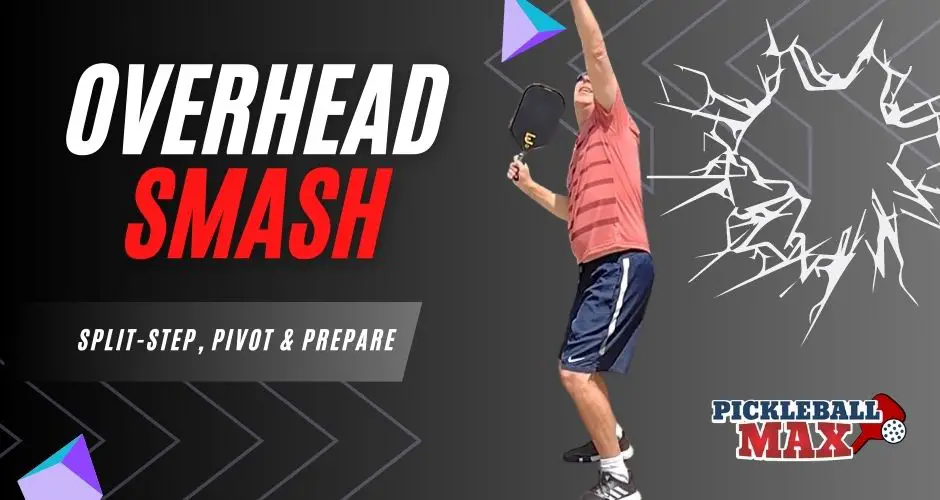
A pickleball smash represents a mouth-watering, adrenaline-producing opportunity to end a rally and “flex your muscles” to your opponents as you whiz the ball out-of-reach.
An overhead smash is simply a hard – and frequently angled – overhead shot executed off an opponent’s lob. The overhead smash is intended to end the rally. However, with a softer, plastic ball in pickleball (as opposed to tennis) and athletic opponents, ending the rally with just one overhead is becoming more-and-more challenging.
Unfortunately for those who don’t like drilling, executing the overhead smash is easier-said-than-done.
A good pickleball smash requires practice and is a result of effective execution of the following three steps:
Step 1: Split, Pivot & Prepare
Proper positioning at the non-volley line as you ready yourself for your opponent’s shot dictates that your body is square to the ball and your opponent. You’re in an open-stance with your shoulders parallel to the net.
Split Step
Immediately prior to your opponent hitting any shot (lob shot or otherwise), you want to split step – a small hop that puts you on the balls of your feet (and on-balance) and allows for explosive movement in any direction.
Pivot & Prepare
As you realize a lob has been hit, track the ball while pivoting (drop-stepping) and turning your shoulders so they are now perpendicular to the net. Next, prepare for the overhead swing by getting your arms up and in the trophy-pose position – your non-dominant hand pointing up and forward to the ball while you place the paddle (with your dominant hand) behind your ear with your elbow slightly bent.
Step 2: Overhead Footwork
After split-stepping, pivoting and preparing, it’s now time to implement proper footwork as you go back for the overhead so you can do so safely and athletically.
First, here’s what not to do:
It is incredibly important to learn the proper footwork.
Here are three footwork patterns to safely and athletically go back for an overhead:
Footwork Pattern #1: Side Shuffle
Side shuffling is perhaps the safest option. It simply involves shuffling of the feet such that none of your steps cross over. Although it is the most on-balance option, it is also the “slowest-to-get-to-the-ball option.
Footwork Pattern #2: Cross-Over Step
The cross-over step involves moving with your front foot going over the top of your back foot as you move towards the ball. This option is quicker-to-get-to-the-ball, but takes a bit more coordination and practice.
Footwork Pattern #3: Cross-Over, Side Shuffle Combination
The combination is simply a combination where you start going back with the cross-over steps and then your last couple of movements are with the side-shuffle. With this option you have the advantage of quicker movement with the cross-over steps and more on-balance movements as you prepare to hit with the side shuffle. This option also takes more coordination and practice.
Step 3: The Swing
Now that you have split stepped, pivoted, prepared and have implemented appropriate footwork patterns to get to the ball safely and athletically, it’s time for the swing.
With the goal of making contact at the highest point of your swing and in-front of you, begin the swing by shifting your weight from your back foot to front foot – all while leading with the edge of the paddle. Just prior to contact, pronate your forearm so the ball hits firmly and squarely in the middle of the paddle face. This pronation is what will generate paddle head speed and, consequently, pace and penetration on your overhead shot.
Finish your overhead by following through down and slightly across your body.
Options for Overhead Pickleball Smash Placement
As you swing, make sure you’re not just swinging down. The ball will go into the net. Instead, swing out and towards your target. In tennis, an overhead can be smashed and bounced over the back fence and 10 rows into the crowd. In pickleball, however, because of the plastic and softness of the ball (as opposed to a compressed, rubber tennis ball), the ball doesn’t travel that far and fast.
Therefore, consider angling the overhead such that it lands close to the kitchen line and angles off-the-court. That will open up even more angles if your opponent happens to track it down and return it.
Final Thoughts on the Pickleball Smash
The overhead smash in pickleball can be a rally-ending shot – if executed properly. To do so, make sure to split, pivot, prepare and leverage footwork patterns that allow you to move back in the court safely and athletically. Then execute a solid swing by leading with the edge of the paddle, pronating and following through.
And, of course, consider angles when hitting these overheads.
See you on the courts!
creditSource link






